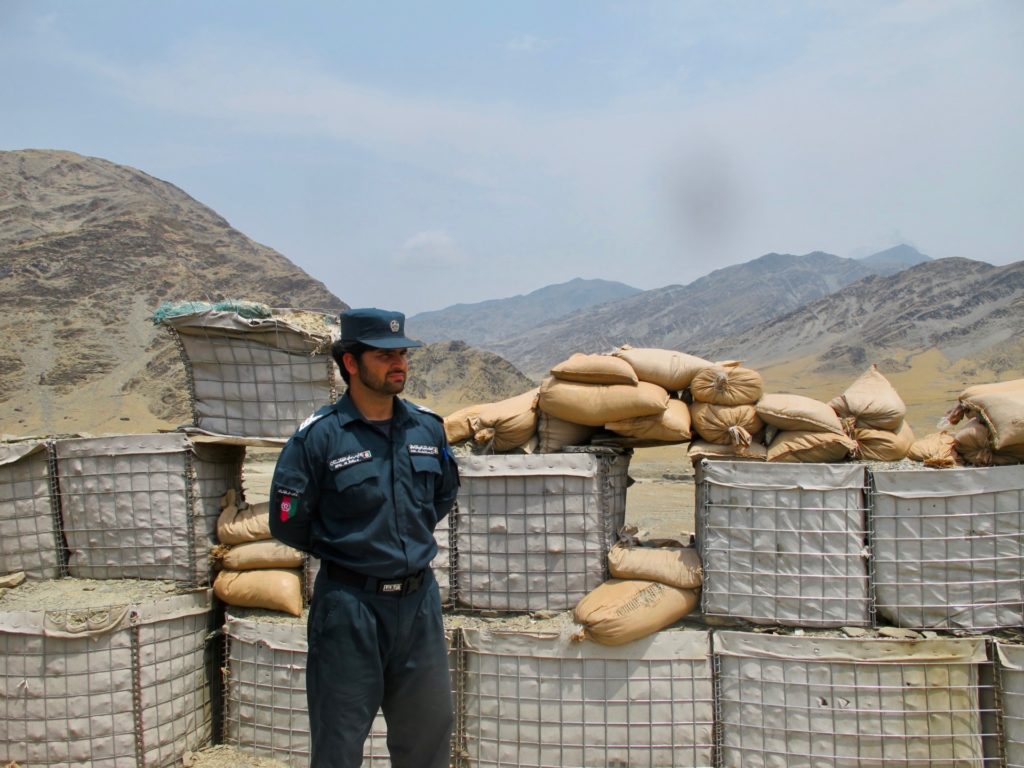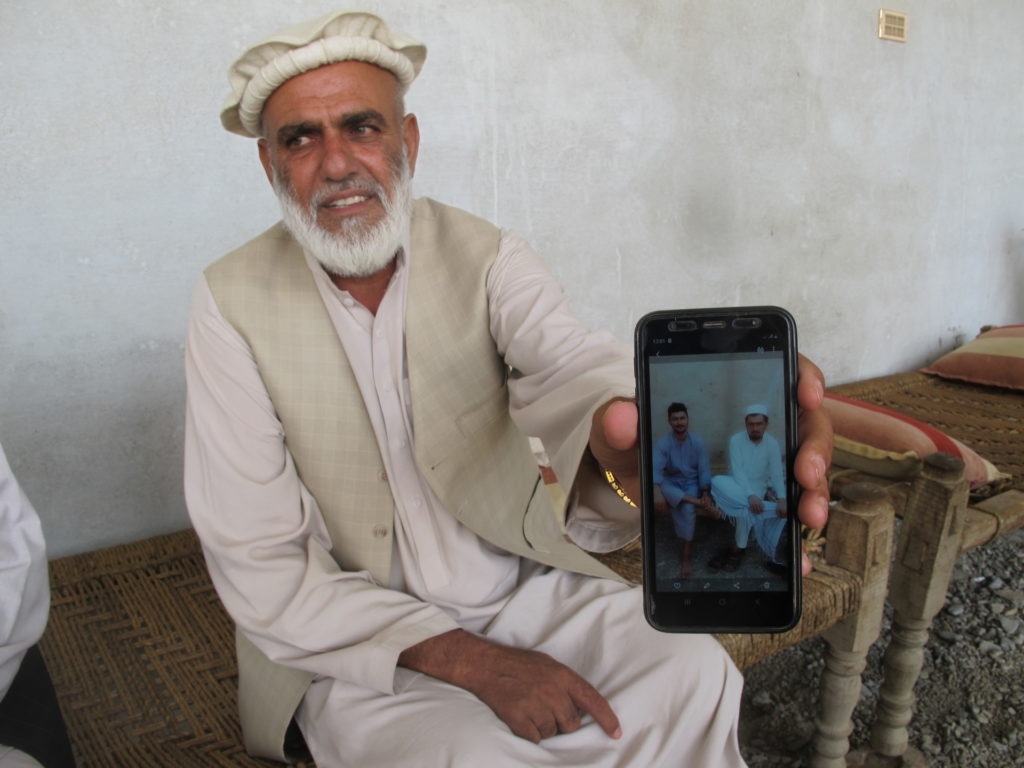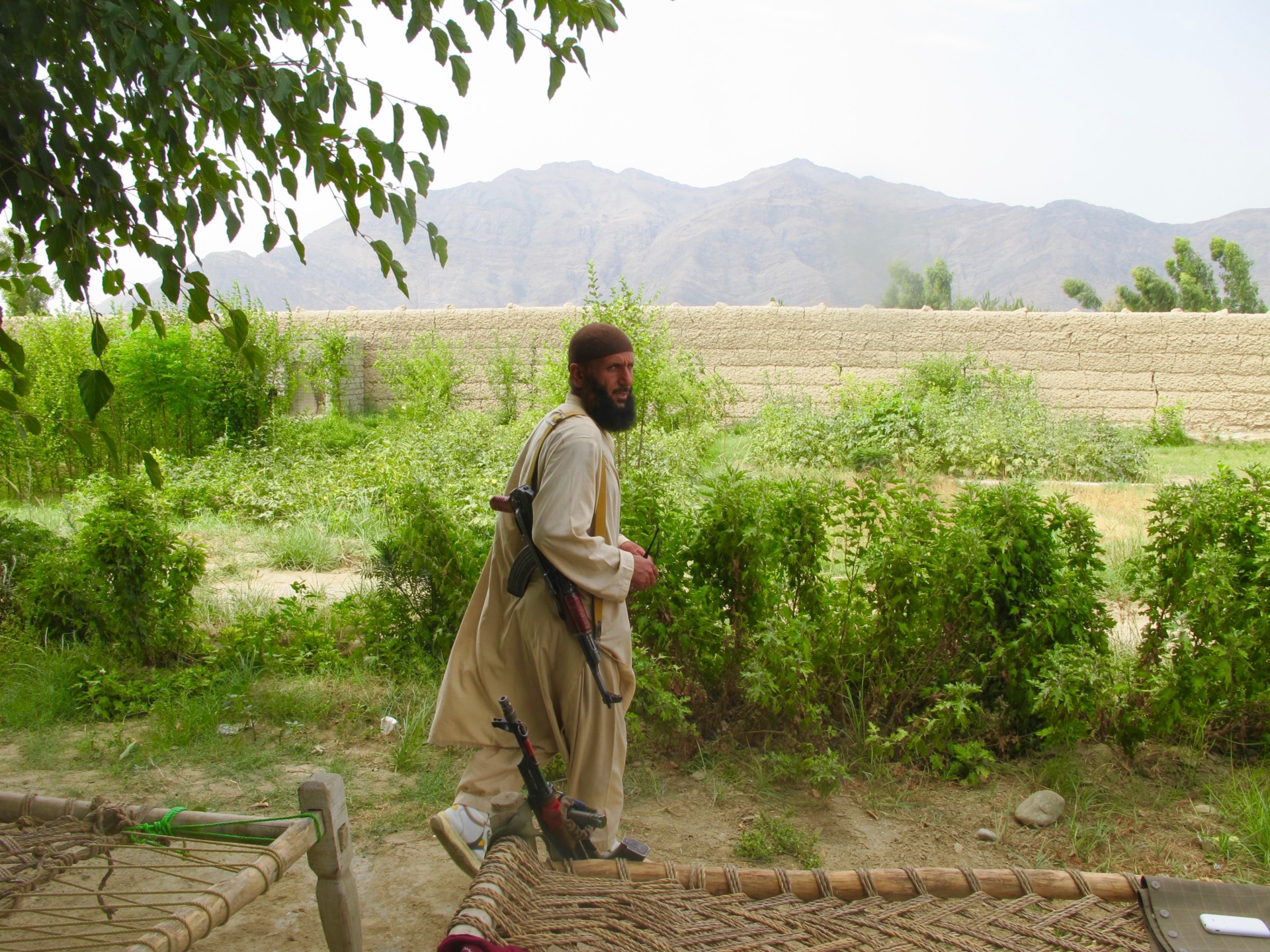One of the younger men, armed with a Kalashnikov and a stern yet curious demeanor, pulled up chairs for me and some of the elders.
In the shade of a large tree and following requisite greetings all around, the commander of one of the local forces fighting against “insurgent groups” in areas near the (never locally) recognized line of demarcation discussed the genesis of the forces and the current situation.
I had been to Nangarhar province — and many others throughout Afghanistan since I first reported from the country in 2010 — but never this close to the mountains that mark the unofficial border with Pakistan.
The province is east of Kabul, and the road to the Pakistani city of Peshawar cuts through it. The Momand Dara district, where I was, is one of 22 in Nangarhar and is south of this road. Those crossing the border nearby do so through much more rugged mountain routes.

Near to where we spoke, inside the perimeter of a walled but scantily protected enclosure, there was a small hut of sorts with a thatched roof and an Afghan flag raised above it, whipping about in the wind. Mountains, in which Taliban cells are known to operate, rose behind.
In recent months, the U.S.-trained and equipped Afghan national armed forces have lost ground to the Taliban as the deadline for the U.S. withdrawal looms closer: By August 31, all U.S. troops will be out of the country. As district after district fell to the Taliban in late July as the United States continued to withdraw, I traveled through Nangarhar, known internationally for being the location of Tora Bora: the former stronghold and hideout of al Qaeda founder Osama bin Laden.
“See this tree here?” Malik Jaafar, the commander and tribal elder, asked while pointing at an enormous tree whose branches were providing shade for us in the early afternoon of a hot summer day. “This is where our uprising began three years ago. Under this tree.” It was where Jaafar and his comrades decided to work against both the Taliban and the local branch of the Islamic State group.
Here, the locals are well aware of the oppression and lack of opportunities for their children that will result under a Taliban regime. Tribal ties are strong, and since many of the older men have fighting experience from previous decades, it seemed only obvious that the local men would come together to fight, they said.
Jaafar said that some of his men had received training and had been getting salaries from the National Directorate of Security (NDS), Afghanistan’s intelligence and security services, since shortly after they started the uprising.
I asked whether — as the Taliban and their backers often claim — any of the men had received training from any Western military forces.
Jaafar practically snorted: “I got training from the KGB during the [Soviet] period, then from Pakistan’s Inter-Intelligence Services (ISI). Then the NDS. Exactly what are the Americans supposed to teach me?”
The NDS has, however, received training from Western intelligence agencies. This, in some Afghan eyes, makes them suspicious; for others, it makes them seem more qualified.
In an effort to shore up support, the Taliban often call the government, and anyone associated with it, “puppets” of the “decadent, corrupt” West. They often accuse any Afghan journalist who speaks out against them of being an “agent of the CIA.” The CIA has been involved in multiple operations in Afghanistan since the 1970s and supported Afghan commanders and warlords who have since become known for their brutality, including the father of the current deputy leader of the Taliban.
In recent years, Nangarhar province has had to deal with not only the Taliban but also the local branch of ISIS, often referred to as Islamic State Khorasan Province (ISKP).
ISKP has been known to be active in the country since 2015. Since 2017, several of its leaders have been killed by U.S. airstrikes and joint Afghan-U.S. operations. Nangarhar was, in previous years, its stronghold.
Initially, some saw the much-trumpeted appearance of the ISKP as more of a diversionary tactic that could be exploited as an excuse to call for support to the Taliban “to fight ISIS,” which has often been seen as a bigger danger.
Iran, for example, had reportedly been supporting the Taliban – or at least factions of it – prior to the emergence of ISKP but was later reported to be more openly supporting it as a sort of bulwark against the local branch of ISIS.
ISKP and the Taliban have at times fought viciously against each other in the country; some have left one to join the other out of grievances or for other reasons. Some claim, however, that both groups collaborate in various ways with al Qaeda when it serves their purpose.
ISKP has often taken responsibility for some of the cruelest attacks, such as on girls’ schools. Some have cited suspicions that this may be a way for the Taliban to avoid blame for attacks that would erode their desired image as the “saviors” from the “corrupt Afghan government.” Others claim ISKP simply has a more extreme ideological stance and is more concerned with invoking fear while the Taliban must also try to garner public support for their ends.
There is no evidence of collaboration between ISKP and the Taliban. But the Afghan perception of their collaboration or conspiracy shows just how murky the struggle for power in this war-ravaged country is, and how it is likely to become more so in the absence of NATO forces.
ISKP has also claimed responsibility for a number of targeted attacks this year on individuals in the provincial capital of Jalalabad, including the assassination of a number of female journalists as well as the assassination in early August of an adviser to the Nangarhar provincial council.
The United Nations has warned in recent months that al Qaeda, ISIS and other groups with foreign fighters retain a presence in the country. The Taliban have long worked closely with al Qaeda, and most observers say that it has no intention of cutting ties with the group.
Meanwhile, debate had raged in recent months, especially among the more educated and politically engaged classes in Kabul, about the wisdom of arming “former warlords” and civilians to ward off Taliban attacks.
This debate had mostly subsided by early August when it seemed clear that without these “uprising” forces, led by tribal elders, former mujahedeen and “warlords,” it would likely be impossible to hold many areas of the country.
The image of white-bearded Ismail Khan, over 70 years old, leading his fighters in battle to save Afghanistan’s western city of Herat from a Taliban incursion led some Kabul-based women to say they regret previous statements against “these warlords” and state in tweets that the men should actually be considered “heroes.”
In the border district of Momand Dara there are two of these tribal uprising forces: one under Jaafar and the other under another tribal elder, Malik Baseer.
When I met with Baseer at his base, not far from Jaafar’s and reached via a dusty and unpaved but tree-lined road, I was greeted by a slew of boys in brightly colored shalwar kameez, armed teenagers and men in their 20s, and the tribal elder and commander himself.
Sweet, yellowish, Afghan raisins and green tea were offered as Baseer spoke about his “duty to fight as community elder.”
He had lost four of his sons in the fighting against both ISKP and the Taliban in the past three years, he said, showing photos of his sons and noting that some of them had children of their own whom he is now taking care of.

He looked pained when he answered a question about whether he sent his daughters to school.
He noted that he thought education was very important for men and women. But for now, since they are particularly at risk because they are his relatives, he cannot keep them in school. He added that he had plans to build an institute to study agriculture nearby, “when all this is over.”
He said, with unmistakable sadness, that he had always thought education was important since he had never had the chance to learn to read.
Less than half of Afghanistan’s population is literate: only 43% according to U.N. figures from 2020, though this is still a significant improvement from 2001. Both education and increased media freedoms are considered in grave danger if the Taliban end up taking control of the entire country.
During a car journey earlier that morning, a professor of Islamic law who accompanied me for the day suddenly pointed off to the left.
“The Taliban used to hold trials in clearings in that area. And executions,” he said. “They made tribal elders sit on explosives and just blew them up.”
Though some claim a strong link between the Pashtun community and the Taliban, many here claim that the Taliban were the most brutal with Pashtuns and killed more of them than of any other ethnic group in the country.
This is consistent with what often seems willful ignorance by some analysts of the fact that Sunni Arabs in the Middle East are often the prime targets of ISIS, even if ISIS portrays itself as a “Sunni Muslim” group.
Many in Afghanistan blame Pakistan — and more specifically the Pakistan military — for supporting the Taliban, providing refuge for its fighters and allegedly financial support, as well as training.
There is evidence for this, as there is for Iran supporting some factions of the Taliban closer to its border. Experts note, however, that the Taliban also has significant income streams from drug trafficking, taxing locals, customs revenue at “unofficial” border crossings and other sources.
In the provincial capital of Jalalabad with its palatial governor’s residence and a university that attracts students from across the country, Nangarhar provincial governor Ziaulhaq Amarkhil has long condemned, in the most strident terms, Pakistani interference in the country.
Amarkhil, who speaks fluent English and has studied and worked abroad in nations including Italy and Nepal, is also a senior adviser to the president. In a July 18 interview at his office, he told me that he had just returned from inspecting checkpoints in the same district as the infamous Tora Bora. He explained that “Nangarhar is one of the biggest and most populated provinces in Afghanistan. There are 22 districts in Nangarhar and there is government presence, alhamdulillah, in all of them.”
As of early August, the Afghan government had reportedly lost more than half of its districts across the country to the Taliban.
When asked why he felt Nangarhar had thus far held up better than the rest of the country, he told New Lines, “My priority is to solve small issues before they become bigger.” Describing the issues, Amarkhil continued: “if the checkpoint has a water issue, ammunition issue; if there are not enough forces at the checkpoint; if the forces are not getting their salaries on time; if there is no coordination between remote areas and other areas near them — in case they are under attack, the others should support them.
“This is the first thing I focused on,” he said, “and that is why we are not losing any checkpoints. Plus, I am traveling a lot. I go and sit and listen to them. But not only listening. I set myself a limit of three days. I must solve their problems within three days.
“Honestly, they are fighting with Pakistan. Pakistan is fighting with Afghans. The Taliban is fully supported by Pakistan. Yesterday I sent two dead bodies to Pakistan,” Amarkhil said.
An interior ministry source involved in analyzing online support for the group told me in late July that the vast majority of the thousands of tweets they had analyzed and considered “pro-Taliban” are from Pakistan-based accounts, presumably as part of a concerted propaganda effort.
Kandahar also shares a border with Pakistan. Its Chaman-Spin Boldak border crossing was taken by the Taliban on July 14. The Torkham border crossing with Pakistan in the Nangarhar province instead remains under government control.
“Where are they coming from? Their families are there. Pakistan is sending them to destroy this country. More than 10,000 Pakistanis have crossed in the past two or three months,” Amarkhil claimed.
“We have a border of more than 2,000 kilometers [1,240 miles]. It’s not something small that we can have control over,” he said, exasperated. “Hundreds of small and big crossings are there.”
An estimated 3 million Afghans are in Pakistan, having sought refuge there during the 1979 Soviet invasion of Afghanistan or subsequent conflicts over the past 40 years, according to the U.N.
On the issue of ISKP, or ISIS, Amarkhil said that it “controlled some parts of Nangarhar two years ago. The governor cleared those areas, but some came to the city because it is easier to hide in the city. It was not easy for the Afghan government to find them. For the past 10 months I keep doing operations inside the [Jalalabad]. I have been governor for almost a year and every day I am arresting some.
“But there is a big change in Nangarhar now. IS are defeated and the Taliban are not that strong in the province,” he claimed. “Thank God. The people are really helpful to us in this province.”
He said that 40 Taliban had been killed the night before in the Sherzad district of the province.
“We support the peace process. Taliban are Afghans. We want them to come to the table,” Amarkhil said. “But we have some red lines: freedom of speech, human rights, women’s rights, education rights,” adding, however: “Honestly, though? The Taliban do not want peace. They want to fight.
“We released 5,000 prisoners,” Amarkhil noted, ostensibly as part of the “peace process” but in reality, as many Afghans noted to me over a month’s stay in the country in July and August, as an “order” from the U.S. that had no backing from Afghans.
The men released, Amarkhil noted, “went back to fight.”
The release of 5,000 Taliban prisoners from Afghan prisons was part of a deal reached between the U.S. and the Taliban in February 2020. The Taliban and the U.S. both put pressure on the Afghan government to comply with it. Many of those released are known to have returned to fighting and some are now commanders in key areas.
One of Amarkhil’s advisers said he is known for visiting some of these checkpoints in border areas at night, to ensure that the men are actually doing their job: key, they say, to keeping in touch with the situation and people on the ground as well as making sure security forces do not “slack off.”
One also noted that the governor had replaced 18 of the 22 district governors in the province in the past year in an attempt to bring in greater professionalism and younger individuals.
Some of Amarkhil’s advisers are former journalists who are more likely to have traveled widely across the country and can advise on what may work at the local level.
In an interview in late July with Momand Dara district governor Najibullah Anwarzai, he noted that he had worked as a journalist for 11 years. He said that he had been chosen as a governor also because of his family’s history of fighting, including against the British long ago, and because of the general high esteem that the local community has for his family.
Throughout the interview, Anwarzai refused to distinguish between the Taliban and ISIS/ISKP, simply referring to them as “the enemy.”
“Nine years ago, we couldn’t have been sitting here. The enemies had control, then. Now the area has come under control of the government” after the people rose up against the Taliban and ISIS, he said.
The night before, he noted, “there was an operation on some of the enemies” and “there are some areas of the district where the enemy are still operating.”
The district governor gave me permission to visit and accompanied me to one of the checkpoints along the “border.”
As we drove through areas with rocky outcrops and passed a school that had been rebuilt after the Taliban destroyed it, the professor of Islamic law, who is originally from the area, suggested that the local population’s prior experience with the Taliban has been key in preventing the group from taking over the area.
“Neither [ISIS or Taliban] have any idea what Islam is. They believe God is bestial, like them,” he said with unveiled disgust.
“They killed so many of the educated people and tribal elders,” he added. “They ordered the local people to come and watch.”
Reminiscing as we drove through one area, he said that his father had died shortly after he was born and that his mother had raised him and his siblings alone.
“She went alone across these mountains to Pakistan. I had been born only a few months before. She already had two young children — my brother and sister. She took a donkey but had to abandon it in the mountains at some point because the terrain was so difficult. But she made it,” he said. “And she taught us so much.”
“Afghans are mountain people — they are strong,” he said. “And they will resist. Inshallah.”
A few weeks later in August, ISKP claimed three attacks in a single day, all targeting people and places in Nangarhar. Several other provincial capitals across the country had meanwhile fallen to the Taliban in quick succession.
A storm has been brewing, but it is still too soon to tell how well the province will weather it.



